Observed Daily Profiles of Polyaromatic Hydrocarbons and Quinones in the Gas and PM1 Phases: Sources and Secondary Production in a Metropolitan Area of Mexico
Abstract
1. Introduction
2. Materials and Methods
2.1. Study Area
2.2. Sampling Site
2.3. PAHs and Quinones Sampling
2.4. Analytical Procedures
2.5. Gas Chromatography–Mass Spectrometry (GC–MS)
2.6. Quality Assurance/Quality Control (QA/QC)
2.7. Meteorological Parameters
2.8. Diagnostic Ratios
2.9. Statistical Analysis
2.10. Polar Plot Analysis
3. Results and Discussion
3.1. PAHs
3.1.1. Ambient Levels and Distribution
3.1.2. PAH Diagnostic Ratios
3.1.3. PAHs and Influence of Primary Emissions
3.2. Quinones
3.2.1. Ambient Levels and Distribution
3.2.2. Possible Sources
3.2.3. Cluster Analysis
3.3. Limitations
4. Conclusions
Supplementary Materials
Author Contributions
Funding
Acknowledgments
Conflicts of Interest
References
- Rengarajan, T.; Rajendran, P.; Nandakumar, N.; Lokeshkumar, B.; Rajendran, P.; Nishigaki, I. Exposure to polycyclic aromatic hydrocarbons with special focus on cancer. Asian Pac. J. Trop. Biomed. 2015, 5, 182–189. [Google Scholar] [CrossRef]
- Di Filippo, P.; Pomata, D.; Riccardi, C.; Buiarelli, F.; Gallo, V. Oxygenated polycyclic aromatic hydrocarbons in size-segregated urban aerosol. J. Aerosol Sci. 2015, 87, 126–134. [Google Scholar] [CrossRef]
- Nalin, F.; Golly, B.; Besombes, J.L.; Pelletier, C.; Aujay-Plouzeau, R.; Verlhac, S.; Dermigny, A.; Fievet, A.; Karoski, N.; Dubois, P.; et al. Fast oxidation processes from emission to ambient air introduction of aerosol emitted by residential log wood stoves. Atmos. Environ. 2016, 143, 15–26. [Google Scholar] [CrossRef]
- Wnorowski, A. Characterization of the ambient air content of parent polycyclic aromatic hydrocarbons in the Fort McKay region (Canada). Chemosphere 2017, 174, 371–379. [Google Scholar] [CrossRef] [PubMed]
- Shang, Y.; Zhang, L.; Jiang, Y.; Li, Y.; Lu, P. Airborne quinones induce cytotoxicity and DNA damage in human lung epithelial A549 cells: The role of reactive oxygen species. Chemosphere 2014, 100, 42–49. [Google Scholar] [CrossRef] [PubMed]
- Xia, T.; Korge, P.; Weiss, J.N.; Li, N.; Venkatesen, M.I.; Sioutas, C.; Nel, A. Quinones and aromatic chemical compounds in particulate matter induce mitochondrial dysfunction: Implications for ultrafine particle toxicity. Environ. Health Perspect. 2004, 112, 1347–1358. [Google Scholar] [CrossRef] [PubMed]
- Baek, S.O.; Goldstone, M.E.; Lester, J.N.; Perry, R. Phase distribution and particle size dependency of polycyclic aromatic in the urban atmosphere. Chemosphere 1991, 22, 503–520. [Google Scholar] [CrossRef]
- Chen, G.; Li, S.; Zhang, Y.; Zhang, W.; Li, D.; Wei, X.; He, Y.; Bell, M.L.; Williams, G.; Marks, G.B.; et al. Articles Effects of ambient PM1 air pollution on daily emergency hospital visits in China: An epidemiological study. Lancet Planet. Health 2014, 1, e221–e229. [Google Scholar] [CrossRef]
- Lee, H.H.; Choi, N.R.; Lim, H.B.; Yi, S.M.; Kim, Y.P.; Lee, J.Y. Characteristics of oxygenated PAHs in PM10 at Seoul, Korea. Atmos. Pollut. Res. 2018, 9, 112–118. [Google Scholar] [CrossRef]
- Yassaa, N.; Meklati, B.Y.; Cecinato, A.; Marino, F. Organic aerosols in urban and waste landfill of Algiers metropolitan area: Occurrence and sources. Environ. Sci. Technol. 2001, 35, 306–311. [Google Scholar] [CrossRef] [PubMed]
- Valavanidis, A.; Fiotakis, K.; Vlahogianni, T.; Papadimitriou, V.; Pantikaki, V. Determination of selective quinones and quinoid radicals in airborne particulate matter and vehicular exhaust particles. Environ. Chem. 2006, 3, 118–123. [Google Scholar] [CrossRef]
- Castells, P.; Santos, F.J.; Galceran, M.T. Development of a sequential supercritical fluid extraction method for the analysis of nitrated and oxygenated derivatives of polycyclic aromatic hydrocarbons in urban aerosols. J. Chromatogr. A 2003, 1010, 141–151. [Google Scholar] [CrossRef]
- Chung, M.Y.; Lazaro, R.A.; Lim, D.; Jackson, J.; Lyon, J.; Rendulic, D.; Hasson, A.S. Aerosol-borne quinones and reactive oxygen species generation by particulate matter extracts. Environ. Sci. Technol. 2006, 40, 4880–4886. [Google Scholar] [CrossRef] [PubMed]
- Delgado-Saborit, J.M.; Alam, M.S.; Godri Pollitt, K.J.; Stark, C.; Harrison, R.M. Analysis of atmospheric concentrations of quinones and polycyclic aromatic hydrocarbons in vapour and particulate phases. Atmos. Environ. 2013, 77, 974–982. [Google Scholar] [CrossRef]
- Eiguren-Fernandez, A.; Miguel, A.H.; Di Stefano, E.; Schmitz, D.A.; Cho, A.K.; Thurairatnam, S.; Avol, E.L.; Froines, J.R. Atmospheric Distribution of Gas- and Particle-Phase Quinones in Southern California. Aerosol Sci. Technol. 2008, 42, 854–861. [Google Scholar] [CrossRef]
- Tomaz, S.; Jaffrezo, J.L.; Favez, O.; Perraudin, E.; Villenave, E.; Albinet, A. Sources and atmospheric chemistry of oxy- and nitro-PAHs in the ambient air of Grenoble (France). Atmos. Environ. 2017, 161, 144–154. [Google Scholar] [CrossRef]
- Elminir, H.K. Dependence of urban air pollutants on meteorology. Sci. Total Environ. 2005, 350, 225–237. [Google Scholar] [CrossRef] [PubMed]
- Schäfer, K.; Elsasser, M.; Arteaga-Salas, J.M.; Gu, J.; Pitz, M.; Schnelle-Kreis, J.; Cyrys, J.; Emeis, S.; Prevot, A.S.H.; Zimmermann, R. Source apportionment and the role of meteorological conditions in the assessment of air pollution exposure due to urban emissions. Atmos. Chem. Phys. Discuss. 2014, 14, 2235–2275. [Google Scholar] [CrossRef]
- Xu, W.; Han, T.; Du, W.; Wang, Q.; Chen, C.; Zhao, J.; Zhang, Y.; Li, J.; Fu, P.; Wang, Z.; et al. Effects of aqueous-phase and photochemical processing on secondary organic aerosol formation and evolution in Beijing, China. Environ. Sci. Technol. 2017, 51, 762–770. [Google Scholar] [CrossRef] [PubMed]
- Tsapakis, M.; Stephanou, E.G. Diurnal cycle of PAHs, nitro-PAHs, and oxy-PAHs in a high oxidation capacity marine background atmosphere. Environ. Sci. Technol. 2007, 41, 8011–8017. [Google Scholar] [CrossRef] [PubMed]
- Tsapakis, M.; Stephanou, E.G. Collection of gas and particle semi-volatile organic compounds: Use of an oxidant denuder to minimize polycyclic aromatic hydrocarbons degradation during high-volume air sampling. Atmos. Environ. 2003, 37, 4935–4944. [Google Scholar] [CrossRef]
- Albinet, A.; Leoz-Garziandia, E.; Budzinski, H.; Villenave, E. Sampling precautions for the measurement of nitrated polycyclic aromatic hydrocarbons in ambient air. Atmos. Environ. 2007, 41, 4988–4994. [Google Scholar] [CrossRef][Green Version]
- Dai, A.; Wang, J. Diurnal and Semidiurnal Tides in Global Surface Pressure Fields. J. Atmos. Sci. 1999, 56, 3874–3891. [Google Scholar] [CrossRef]
- Fuzzi, S.; Baltensperger, U.; Carslaw, K.; Decesari, S.; Denier Van Der Gon, H.; Facchini, M.C.; Fowler, D.; Koren, I.; Langford, B.; Lohmann, U.; et al. Particulate matter, air quality and climate: Lessons learned and future needs. Atmos. Chem. Phys. 2015, 15, 8217–8299. [Google Scholar] [CrossRef]
- Turpin, B.J.; Saxena, P.; Andrews, E. Measuring and simulating particulate organics in the atmosphere: Problems and prospects. Atmos. Environ. 2000, 34, 2983–3013. [Google Scholar] [CrossRef]
- Eatough, D.J.; Sedar, B.; Lewis, L.; Hansen, L.D.; Lewis, E.A.; Farber, R.J. Determination of Semivolatile Organic Compounds in Particles in the Grand Canyon Area. Aerosol Sci. Technol. 1989, 10, 438–449. [Google Scholar] [CrossRef]
- Dragan, G.C.; Kohlmeier, V.; Breuer, D.; Blaskowitz, M.; Karg, E.; Zimmermann, R. On the challenges of measuring semi-volatile organic compound aerosols using personal samplers. Gefahrstoffe Reinhaltung Luft 2017, 77, 411–415. [Google Scholar]
- Keyte, I.J.; Harrison, R.M.; Lammel, G. Chemical reactivity and long-range transport potential of polycyclic aromatic hydrocarbons—A review. Chem. Soc. Rev. 2013, 42, 9333. [Google Scholar] [CrossRef] [PubMed]
- Lv, Y.; Li, X.; Ting Xu, T.; Tao Cheng, T.; Yang, X.; Min Chen, J.; Iinuma, Y.; Herrmann, H. Size distributions of polycyclic aromatic hydrocarbons in urban atmosphere: Sorption mechanism and source contributions to respiratory deposition. Atmos. Chem. Phys. 2016, 16, 2971–2983. [Google Scholar] [CrossRef]
- Reisen, F.; Arey, J. Atmospheric reactions influence seasonal PAH and nitro-PAH concentrations in the Los Angeles basin. Environ. Sci. Technol. 2005, 39, 64–73. [Google Scholar] [CrossRef] [PubMed]
- Alam, M.S.; Keyte, I.J.; Yin, J.; Stark, C.; Jones, A.M.; Harrison, R.M. Diurnal variability of polycyclic aromatic compound (PAC) concentrations: Relationship with meteorological conditions and inferred sources. Atmos. Environ. 2015, 122, 427–438. [Google Scholar] [CrossRef]
- Souza, K.F.; Carvalho, L.R.F.; Allen, A.G.; Cardoso, A.A. Diurnal and nocturnal measurements of PAH, nitro-PAH, and oxy-PAH compounds in atmospheric particulate matter of a sugar cane burning region. Atmos. Environ. 2014, 83, 193–201. [Google Scholar] [CrossRef]
- Delhomme, O.; Millet, M. Characterization of particulate polycyclic aromatic hydrocarbons in the east of France urban areas. Environ. Sci. Pollut. Res. 2012, 19, 1791–1799. [Google Scholar] [CrossRef] [PubMed]
- Srivastava, D.; Favez, O.; Bonnaire, N.; Lucarelli, F.; Haeffelin, M.; Perraudin, E.; Gros, V.; Villenave, E.; Albinet, A. Speciation of organic fractions does matter for aerosol source apportionment. Part 2: Intensive short-term campaign in the Paris area (France). Sci. Total Environ. 2018, 634, 267–278. [Google Scholar] [CrossRef] [PubMed]
- Elzein, A.; Dunmore, R.E.; Ward, M.W.; Hamilton, J.F.; Lewis, A.C. Variability of polycyclic aromatic hydrocarbons and their oxidative derivatives in wintertime Beijing, China. Atmos. Chem. Phys. Discuss. 2019, 19, 8741–8758. [Google Scholar] [CrossRef]
- Instituto de Información Estadística y Geográfica, Alcanza Área Metropolitana de Guadalajara los 5 millones de habitantes. Available online: www.iieg.gob.mx (accessed on 11 March 2019).
- Fonseca-Hernández, M.; Tereshchenko, I.; Mayor, Y.G.; Figueroa-Montaño, A.; Cuesta-Santos, O.; Monzón, C. Atmospheric Pollution by PM10 and O3 in the Guadalajara Metropolitan Area, Mexico. Atmosphere (Basel) 2018, 9, 243. [Google Scholar] [CrossRef]
- Sánchez, H.U.R.; García, M.D.A.; Bejaran, R.; Guadalupe, M.E.G.; Vázquez, A.W.; Toledano, A.C.P.; Villasenor, O.D.L.T. The spatial-temporal distribution of the atmospheric polluting agents during the period 2000-2005 in the Urban Area of Guadalajara, Jalisco, Mexico. J. Hazard. Mater. 2009, 165, 1128–1141. [Google Scholar] [CrossRef] [PubMed]
- Nájera-Cedillo, M.; Márquez-Azúa, B.; Sánchez-Gómez, R.; Corona, J.P. Los sistemas de información geográfica como herramienta para observar el comportamiento del ozono en la Zona Metropolitana de Guadalajara. GEOS 2005, 25, 368–376. [Google Scholar]
- Díaz-Torres, J.J.; Hernández-Mena, L.; Murillo-Tovar, M.A.; León-Becerril, E.; López-López, A.; Suárez-Plascencia, C.; Aviña-Rodriguez, E.; Barradas-Gimate, A.; Ojeda-Castillo, V. Assessment of the modulation effect of rainfall on solar radiation availability at the Earth’s surface. Meteorol. Appl. 2017, 24, 180–190. [Google Scholar] [CrossRef]
- Subramanyam, V.; Valsaraj, K.T.; Thibodeaux, L.J.; Reible, D.D. Gas-to-particle partitioning of polycyclic aromatic hydrocarbons in an urban atmosphere. Atmos. Environ. 1994, 28, 3083–3091. [Google Scholar] [CrossRef]
- Fan, X.; Lee, P.K.H.; Brook, J.R.; Mabury, S.A. Improved measurement of seasonal and diurnal differences in the carbonaceous components of urban particulate matter using a denuder-based air sampler. Aerosol Sci. Technol. 2004, 38, 63–69. [Google Scholar] [CrossRef]
- Ward, T.J.; Smith, G.C. High-Volume PUF versus Low-Volume PUF Sampling Comparison for Collecting Gas Plus Particulate Polycyclic Aromatic Hydrocarbons. Aerosol Sci. Technol. 2004, 38, 972–979. [Google Scholar] [CrossRef][Green Version]
- Ojeda-Castillo, V.; López-López, A.; Hernández-Mena, L.; Murillo-Tovar, M.A.; Díaz-Torres, J.; Hernández-Paniagua, I.Y.; del Real-Olvera, J.; León-Becerril, E. Atmospheric Distribution of PAHs and Quinones in the Gas and PM1 Phases in the Guadalajara Metropolitan Area, Mexico: Sources and Health Risk. Atmosphere (Basel) 2018, 9, 137. [Google Scholar] [CrossRef]
- Barradas-Gimate, A.; Murillo-Tovar, M.; Díaz-Torres, J.; Hernández-Mena, L.; Saldarriaga-Noreña, H.; Delgado-Saborit, J.; López-López, A. Occurrence and Potential Sources of Quinones Associated with PM2.5 in Guadalajara, Mexico. Atmosphere (Basel) 2017, 8, 140. [Google Scholar] [CrossRef]
- Tobiszewski, M.; Namieśnik, J. PAH diagnostic ratios for the identification of pollution emission sources. Environ. Pollut. 2012, 162, 110–119. [Google Scholar] [CrossRef] [PubMed]
- Stout, S.A.; Wang, Z. Chemical Fingerprinting Methods and Factors Affecting Petroleum Fingerprints in the Environment. In Standard Handbook Oil Spill Environmental Forensics: Fingerprinting and Source Identification: Second Edition; Academic Press: Cambridge, MA, USA, 2007; pp. 61–129. ISBN 9780128096598. [Google Scholar]
- Stogiannidis, E.; Laane, R. Source Characterization of Polycyclic Aromatic Hydrocarbons by Using Their Molecular Indices: An Overview of Possibilities. In Reviews of Environmental Contamination and Toxicology; Springer: Cham, Switzerland, 2013; Volume 234, pp. 49–133. ISBN 978-3-642-45397-7. [Google Scholar]
- Spracklen, D.V.; Carslaw, K.S.; Kulmala, M.; Kerminen, V.-M.; Mann, G.W.; Sihto, S.-L. The contribution of boundary layer nucleation events to total particle concentrations on regional and global scales. Atmos. Chem. Phys. Discuss. 2006, 6, 7323–7368. [Google Scholar] [CrossRef]
- Carslaw, D.C.; Ropkins, K. Openair—An r package for air quality data analysis. Environ. Model. Softw. 2012, 27–28, 52–61. [Google Scholar] [CrossRef]
- Grange, S.K.; Lewis, A.C.; Carslaw, D.C. Source apportionment advances using polar plots of bivariate correlation and regression statistics. Atmos. Environ. 2016, 145, 128–134. [Google Scholar] [CrossRef]
- Morville, S.; Delhomme, O.; Millet, M. Seasonal and diurnal variations of atmospheric PAH concentrations between rural, suburban and urban areas. Atmos. Pollut. Res. 2011, 2, 366–373. [Google Scholar] [CrossRef]
- Singh, D.K.; Gupta, T. Effect through inhalation on human health of PM1 bound polycyclic aromatic hydrocarbons collected from foggy days in northern part of India. J. Hazard. Mater. 2016, 306, 257–268. [Google Scholar] [CrossRef] [PubMed]
- Eiguren-Fernandez, A.; Avol, E.L.; Thurairatnam, S.; Hakami, M.; Froines, J.R.; Miguel, A.H. Seasonal Influence on Vapor-and Particle-Phase Polycyclic Aromatic Hydrocarbon Concentrations in School Communities Located in Southern California. Aerosol Sci. Technol. 2007, 41, 438–446. [Google Scholar] [CrossRef]
- Vecchi, R.; Marcazzan, G.; Valli, G.; Ceriani, M.; Antoniazzi, C. The role of atmospheric dispersion in the seasonal variation of PM1 and PM2.5 concentration and composition in the urban area of Milan (Italy). Atmos. Environ. 2004, 38, 4437–4446. [Google Scholar] [CrossRef]
- Melymuk, L.; Bohlin, P.; Pozo, K.; Sáňka, O.; Klánová, J. Current Challenges in Air Sampling of Semivolatile Organic Contaminants: Sampling Artifacts and Their Influence on Data Comparability. Environ. Sci. Technol. 2014, 48, 14077–14091. [Google Scholar] [CrossRef] [PubMed]
- Lee, W.-J.; Wang, Y.-F.; Lin, T.-C.; Chen, Y.-Y.; Lin, W.-C.; Ku, C.-C.; Cheng, J.-T. PAH characteristics in the ambient air of traffic-source. Sci. Total Environ. 1995, 159, 185–200. [Google Scholar] [CrossRef]
- Ho, K.F.; Ho, S.S.H.; Lee, S.C.; Cheng, Y.; Chow, J.C.; Watson, J.G.; Louie, P.K.K.; Tian, L. Emissions of gas- and particle-phase polycyclic aromatic hydrocarbons (PAHs) in the Shing Mun Tunnel, Hong Kong. Atmos. Environ. 2009, 43, 6343–6351. [Google Scholar] [CrossRef]
- Wu, S.-P.; Yang, B.-Y.; Wang, X.-H.; Yuan, C.-S.; Hong, H.-S. Polycyclic Aromatic Hydrocarbons in the Atmosphere of Two Subtropical Cities in Southeast China: Seasonal Variation and Gas/Particle Partitioning. Aerosol Air Qual. Res. 2014, 14, 1232–1246. [Google Scholar] [CrossRef]
- Tsapakis, M.; Stephanou, E.G. Occurrence of gaseous and particulate polycyclic aromatic hydrocarbons in the urban atmosphere: Study of sources and ambient temperature effect on the gas/particle concentration and distribution. Environ. Pollut. 2005, 133, 147–156. [Google Scholar] [CrossRef] [PubMed]
- Slezakova, K.; Pires, J.C.M.; Castro, D.; Alvim-Ferraz, M.C.M.; Delerue-Matos, C.; Morais, S.; Pereira, M.C. PAH air pollution at a Portuguese urban area: Carcinogenic risks and sources identification. Environ. Sci. Pollut. Res. 2013, 20, 3932–3945. [Google Scholar] [CrossRef] [PubMed]
- Galarneau, E. Source specificity and atmospheric processing of airborne PAHs: Implications for source apportionment. Atmos. Environ. 2008, 42, 8139–8149. [Google Scholar] [CrossRef]
- Lighty, J.A.S.; Veranth, J.M.; Sarofim, A.F. Combustion aerosols: Factors governing their size and composition and implications to human health. J. Air Waste Manag. Assoc. 2000, 50, 1565–1618. [Google Scholar] [CrossRef] [PubMed]
- Jia, C.; Batterman, S. A critical review of naphthalene sources and exposures relevant to indoor and outdoor air. Int. J. Environ. Res. Public Health 2010, 7, 2903–2939. [Google Scholar] [CrossRef] [PubMed]
- Ravindra, K.; Sokhi, R.; Van Grieken, R. Atmospheric polycyclic aromatic hydrocarbons: Source attribution, emission factors and regulation. Atmos. Environ. 2008, 42, 2895–2921. [Google Scholar] [CrossRef]
- Fang, G.C.; Wu, Y.S.; Chen, J.C.; Chang, C.N.; Ho, T.T. Characteristic of polycyclic aromatic hydrocarbon concentrations and source identification for fine and coarse particulates at Taichung Harbor near Taiwan Strait during 2004-2005. Sci. Total Environ. 2006, 366, 729–738. [Google Scholar] [CrossRef] [PubMed]
- Gu, Z.; Feng, J.; Han, W.; Li, L.; Wu, M.; Fu, J.; Sheng, G. Diurnal variations of polycyclic aromatic hydrocarbons associated with PM2.5 in Shanghai, China. J. Environ. Sci. 2010, 22, 389–396. [Google Scholar] [CrossRef]
- Nadal, M.; Wargent, J.J.; Jones, K.C.; Paul, N.D.; Schuhmacher, M.; Domingo, J.L. Influence of UV-B radiation and temperature on photodegradation of PAHs: Preliminary results. J. Atmos. Chem. 2006, 55, 241–252. [Google Scholar] [CrossRef]
- Li, X.; Guo, X.; Liu, X.; Liu, C.; Zhang, S.; Wang, Y. Distribution and sources of solvent extractable organic compounds in PM2.5 during 2007 Chinese Spring Festival in Beijing. J. Environ. Sci. 2009, 21, 142–149. [Google Scholar] [CrossRef]
- Yang, M.; Ahmed, H.; Wu, W.; Jiang, B.; Jia, Z. Cytotoxicity of Air Pollutant 9,10-Phenanthrenequinone: Role of Reactive Oxygen Species and Redox Signaling. BioMed Res. Int. 2018, 2018, 1–15. [Google Scholar] [CrossRef] [PubMed]
- Kishikawa, N.; Nakao, M.; Ohba, Y.; Nakashima, K.; Kuroda, N. Concentration and trend of 9,10-phenanthrenequinone in airborne particulates collected in Nagasaki city Japan. Chemosphere 2006, 64, 834–838. [Google Scholar] [CrossRef] [PubMed]
- Wang, L.; Atkinson, R.; Arey, J. Formation of 9,10-phenanthrenequinone by atmospheric gas-phase reactions of phenanthrene. Atmos. Environ. 2007, 41, 2025–2035. [Google Scholar] [CrossRef]
- Wnorowski, A.; Charland, J.-P. Profiling quinones in ambient air samples collected from the Athabasca region (Canada). Chemosphere 2017, 189, 55–66. [Google Scholar] [CrossRef] [PubMed]
- Harrison, R.M.; Alam, M.S.; Dang, J.; Ismail, I.M.; Basahi, J.; Alghamdi, M.A.; Hassan, I.A.; Khoder, M. Relationship of polycyclic aromatic hydrocarbons with oxy(quinone) and nitro derivatives during air mass transport. Sci. Total Environ. 2016, 572, 1175–1183. [Google Scholar] [CrossRef] [PubMed]
- Ligockit, M.P.; Pankow, J.F. Measurements of the Gas/Particle Distributions of Atmospheric Organic Compounds. Environ. Sci. Tecnol. 1989, 23, 75–83. [Google Scholar] [CrossRef]
- Jakober, C.A.; Riddle, S.G.; Robert, M.A.; Destaillats, H.; Charles, M.J.; Green, P.G.; Kleeman, M.J. Quinone emissions from gasoline and diesel motor vehicles. Environ. Sci. Technol. 2007, 41, 4548–4554. [Google Scholar] [CrossRef] [PubMed]
- Liu, H. Relationship between organic matter humification and bioavailability of sludge-borne copper and cadmium during long-term sludge amendment to soil. Sci. Total Environ. 2016, 566–567, 8–14. [Google Scholar] [CrossRef] [PubMed]
- Kameda, T. Atmospheric Chemistry of Polycyclic Aromatic Hydrocarbons and Related Compounds. J. Health Sci. 2011, 57, 504–511. [Google Scholar] [CrossRef]
- Liu, F.; Beirle, S.; Zhang, Q.; Van Der A, R.J.; Zheng, B.; Tong, D.; He, K. NOx emission trends over Chinese cities estimated from OMI observations during 2005 to 2015. Atmos. Chem. Phys. 2017, 17, 9261–9275. [Google Scholar] [CrossRef] [PubMed]
- Pankow, J.F.; Storey, J.M.E.; Yamasaki, H. Effects of relative humidity on gas/particle partitioning of semivolatile organic compounds to urban particulate matter. Environ. Sci. Technol. 1993, 27, 2220–2226. [Google Scholar] [CrossRef]
- Salvador, C.M.; Chou, C.C.K. Analysis of semi-volatile materials (SVM) in fine particulate matter. Atmos. Environ. 2014, 95, 288–295. [Google Scholar] [CrossRef]
- Zhao, N.; Zhang, Q.; Wang, W. Atmospheric oxidation of phenanthrene initiated by OH radicals in the presence of O2 and NOx—A theoretical study. Sci. Total Environ. 2016, 563–564, 1008–1015. [Google Scholar] [CrossRef] [PubMed]
- Masiol, M.; Formenton, G.; Pasqualetto, A.; Pavoni, B. Seasonal trends and spatial variations of PM10-bounded polycyclic aromatic hydrocarbons in Veneto Region, Northeast Italy. Atmos. Environ. 2013, 79, 811–821. [Google Scholar] [CrossRef]
- Pfrang, C.; King, M.D.; Braeckevelt, M.; Canosa-Mas, C.E.; Wayne, R.P. Gas-phase rate coefficients for reactions of NO3, OH, O3 and O(3P) with unsaturated alcohols and ethers: Correlations and structure-activity relations (SARs). Atmos. Environ. 2008, 42, 3018–3034. [Google Scholar] [CrossRef]
- Choudhury, D.R. Characterization of Polycyclic Ketones and Quinones in Diesel Emission Particulates by Gas Chromatography/Mass Spectrometryt. Environ. Sci. Technol. 1982, 16, 102–106. [Google Scholar] [CrossRef]
- Helmig, D.; Harger, W.P. OH radical-initiated gas-phase reaction products of phenanthrene. Sci. Total Environ. 1994, 148, 11–21. [Google Scholar] [CrossRef]
- Nordin, E.Z.; Uski, O.; Nyström, R.; Jalava, P.; Eriksson, A.C.; Genberg, J.; Roldin, P.; Bergvall, C.; Westerholm, R.; Jokiniemi, J.; et al. Influence of ozone initiated processing on the toxicity of aerosol particles from small scale wood combustion. Atmos. Environ. 2015, 102, 282–289. [Google Scholar] [CrossRef]
- Eiguren-Fernandez, A.; Miguel, A.H.; Lu, R.; Purvis, K.; Grant, B.; Mayo, P.; Di Stefano, E.; Cho, A.K.; Froines, J. Atmospheric formation of 9,10-phenanthraquinone in the Los Angeles air basin. Atmos. Environ. 2008, 42, 2312–2319. [Google Scholar] [CrossRef]
- Perraudin, E.; Budzinski, H.; Villenave, E. Identification and quantification of ozonation products of anthracene and phenanthrene adsorbed on silica particles. Atmos. Environ. 2007, 41, 6005–6017. [Google Scholar] [CrossRef]
- Ringuet, J.; Leoz-Garziandia, E.; Budzinski, H.; Villenave, E.; Albinet, A. Particle size distribution of nitrated and oxygenated polycyclic aromatic hydrocarbons (NPAHs and OPAHs) on traffic and suburban sites of a European megacity: Paris (France). Atmos. Chem. Phys. 2012, 12, 8877–8887. [Google Scholar] [CrossRef]
- Zhang, Y.; Yang, B.; Gan, J.; Liu, C.; Shu, X.; Shu, J. Nitration of particle-associated PAHs and their derivatives (nitro-, oxy-, and hydroxy-PAHs) with NO3 radicals. Atmos. Environ. 2011, 45, 2515–2521. [Google Scholar] [CrossRef]
- Janhäll, S.; Jonsson, Å.M.; Molnár, P.; Svensson, E.A.; Hallquist, M. Size resolved traffic emission factors of submicrometer particles. Atmos. Environ. 2004, 38, 4331–4340. [Google Scholar]
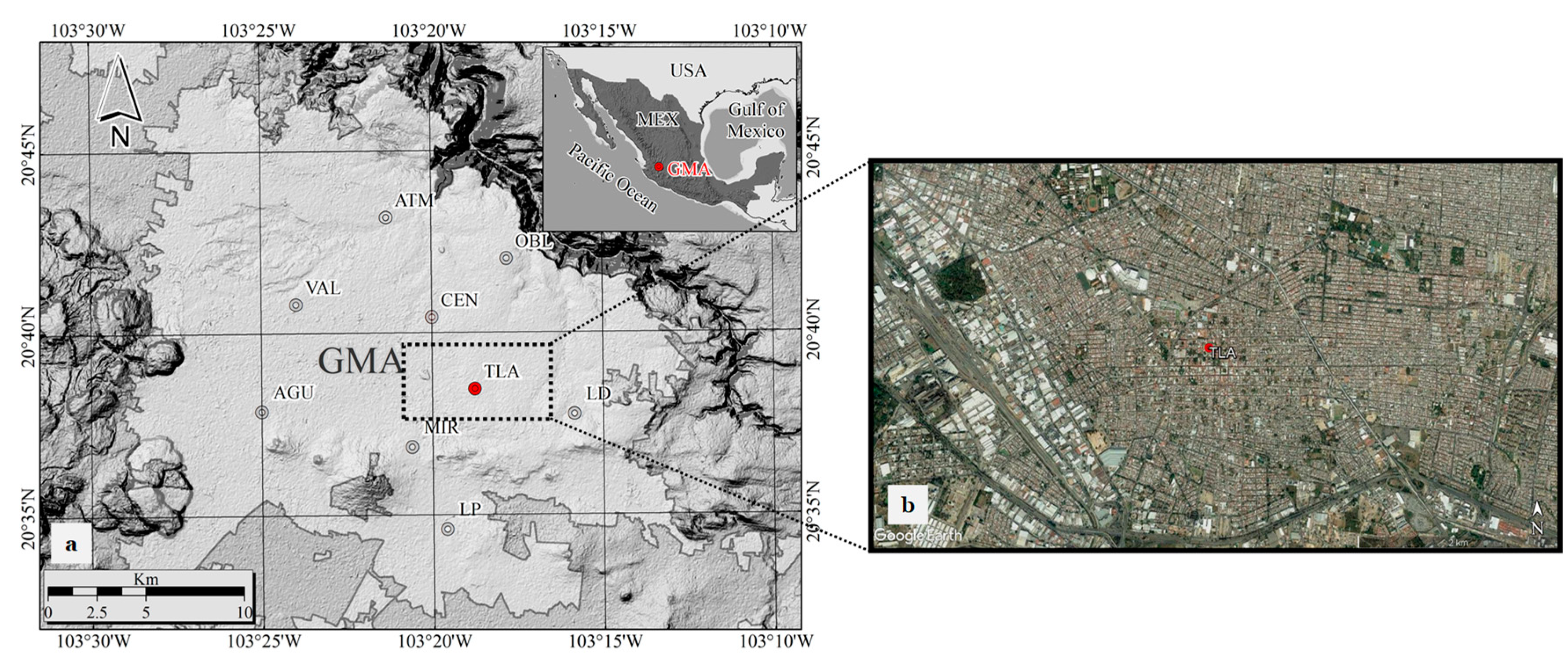
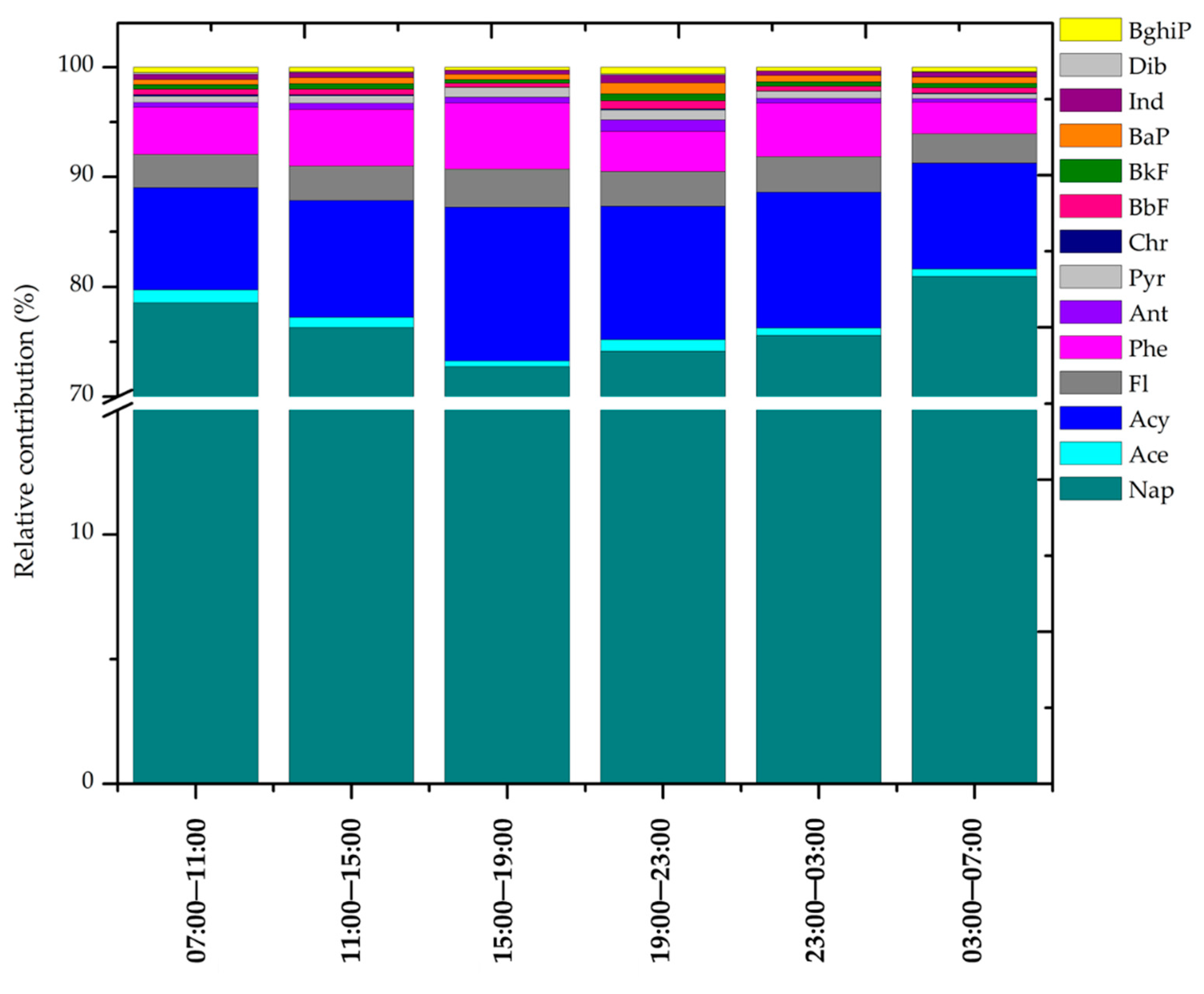
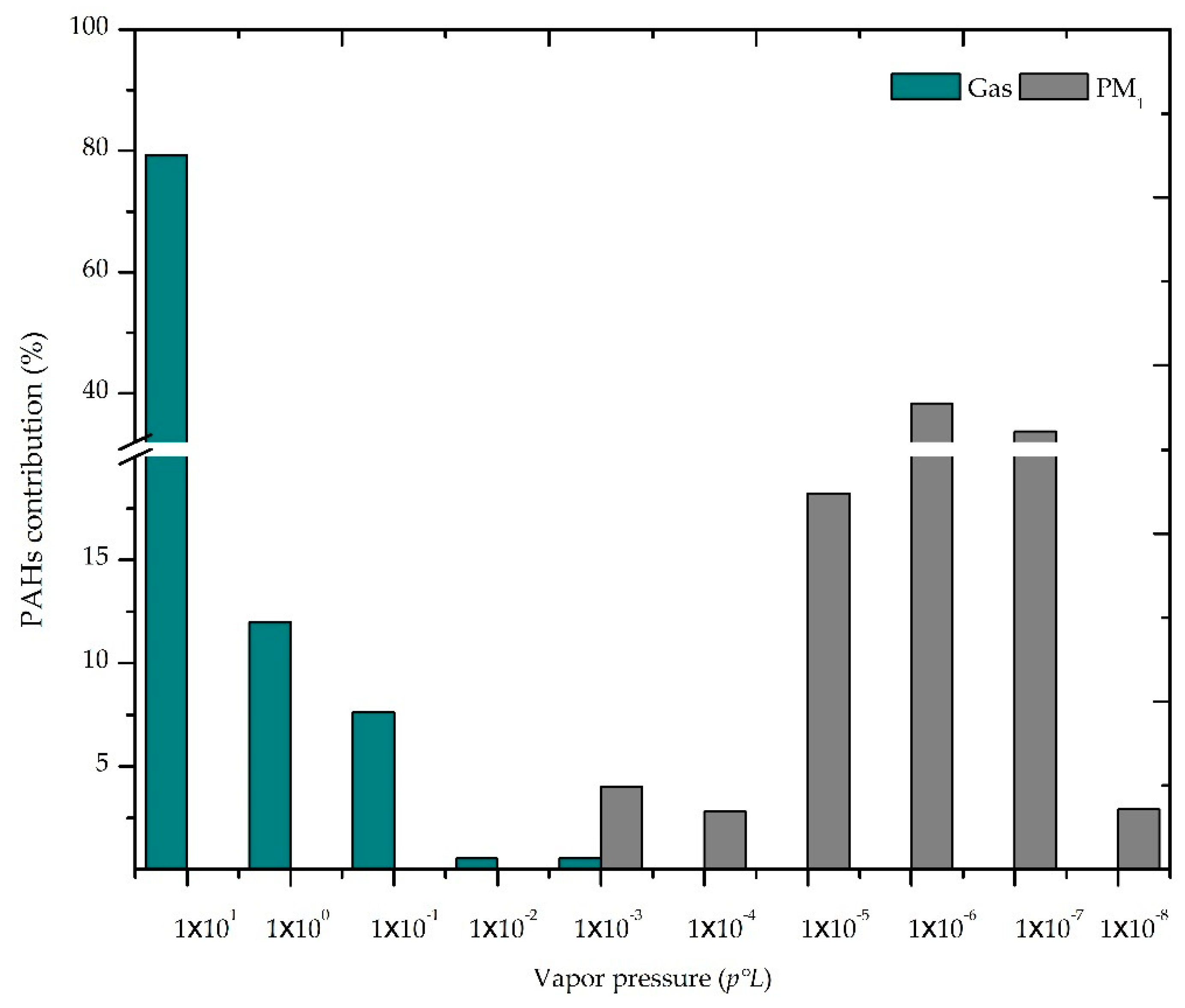
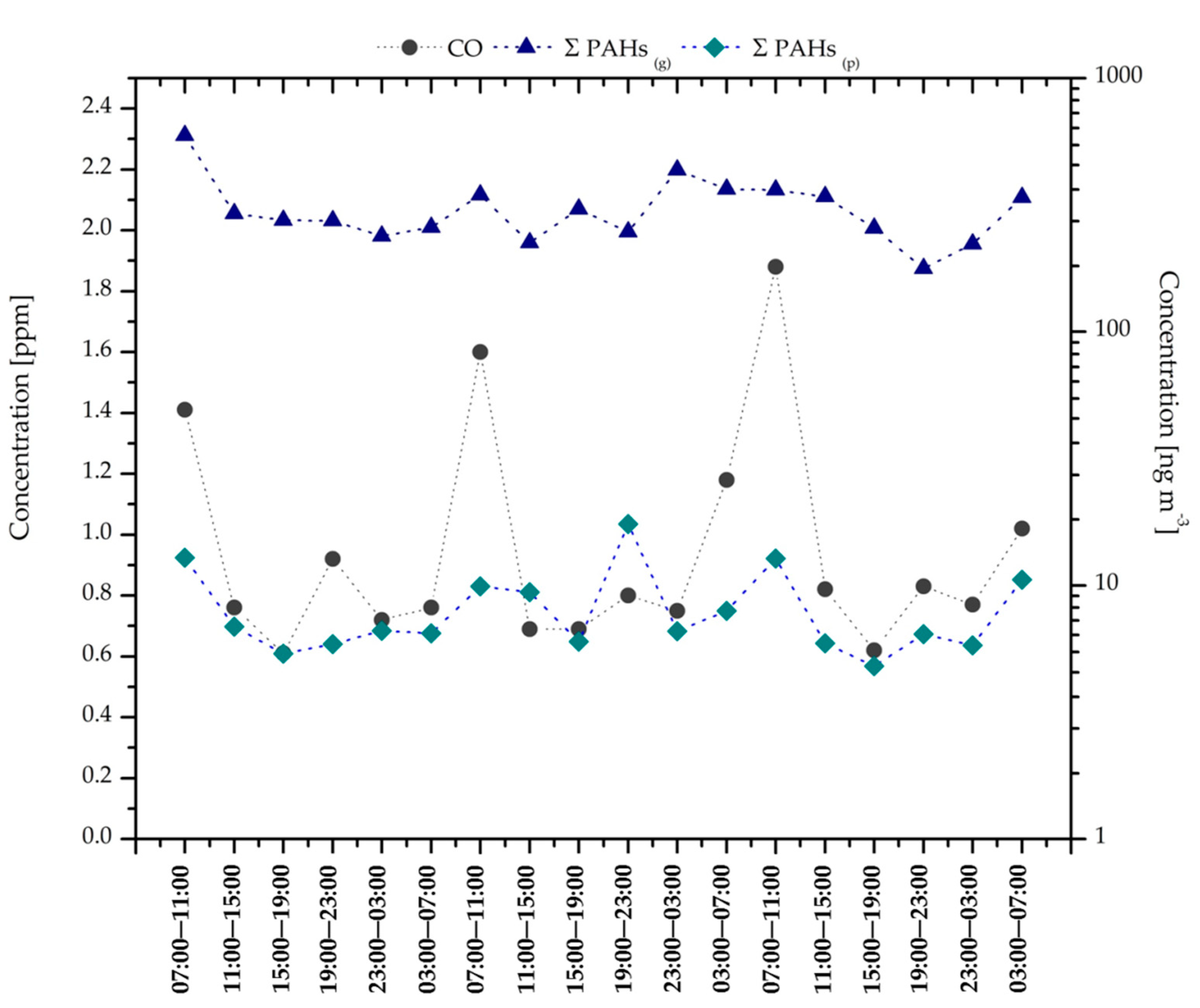
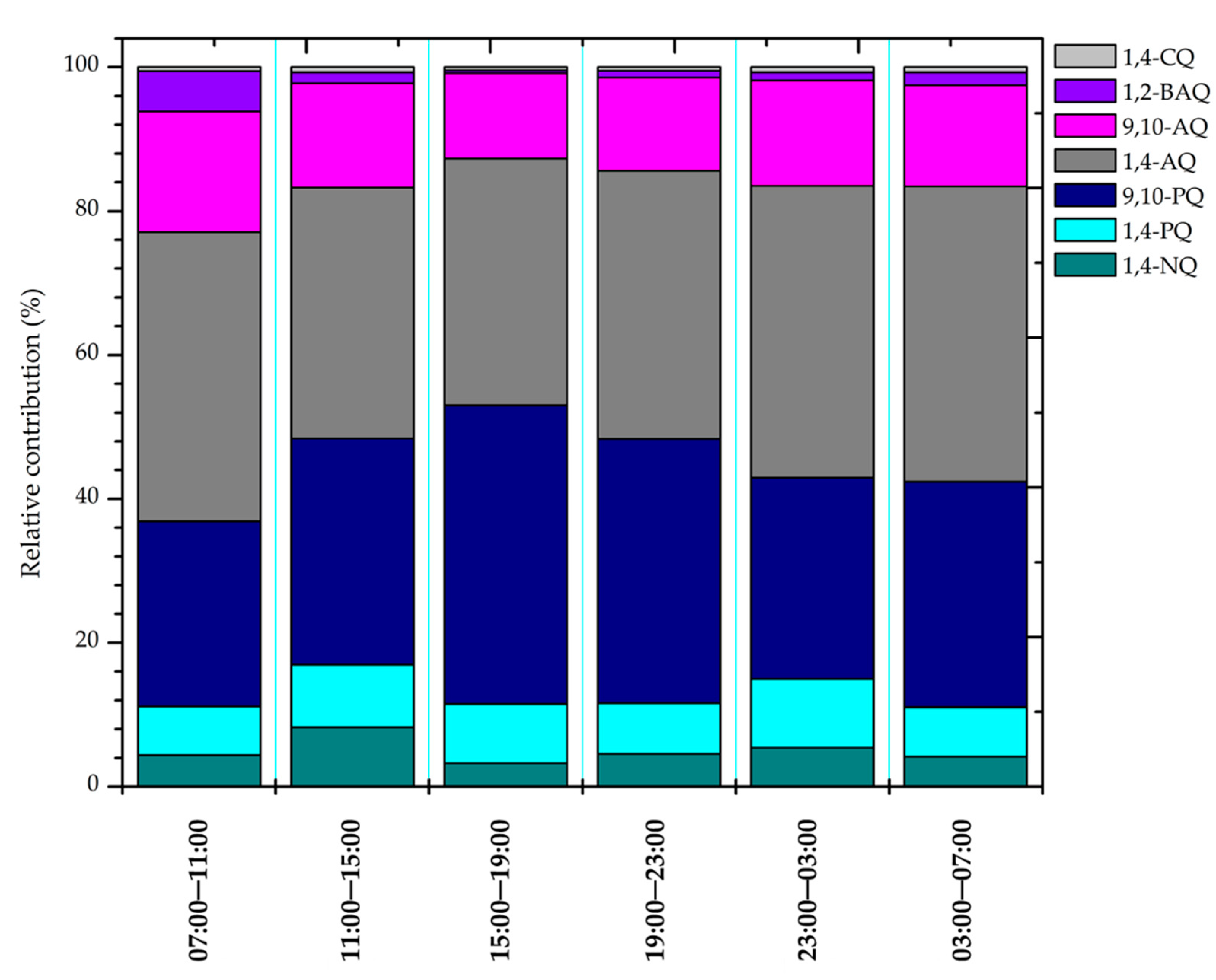
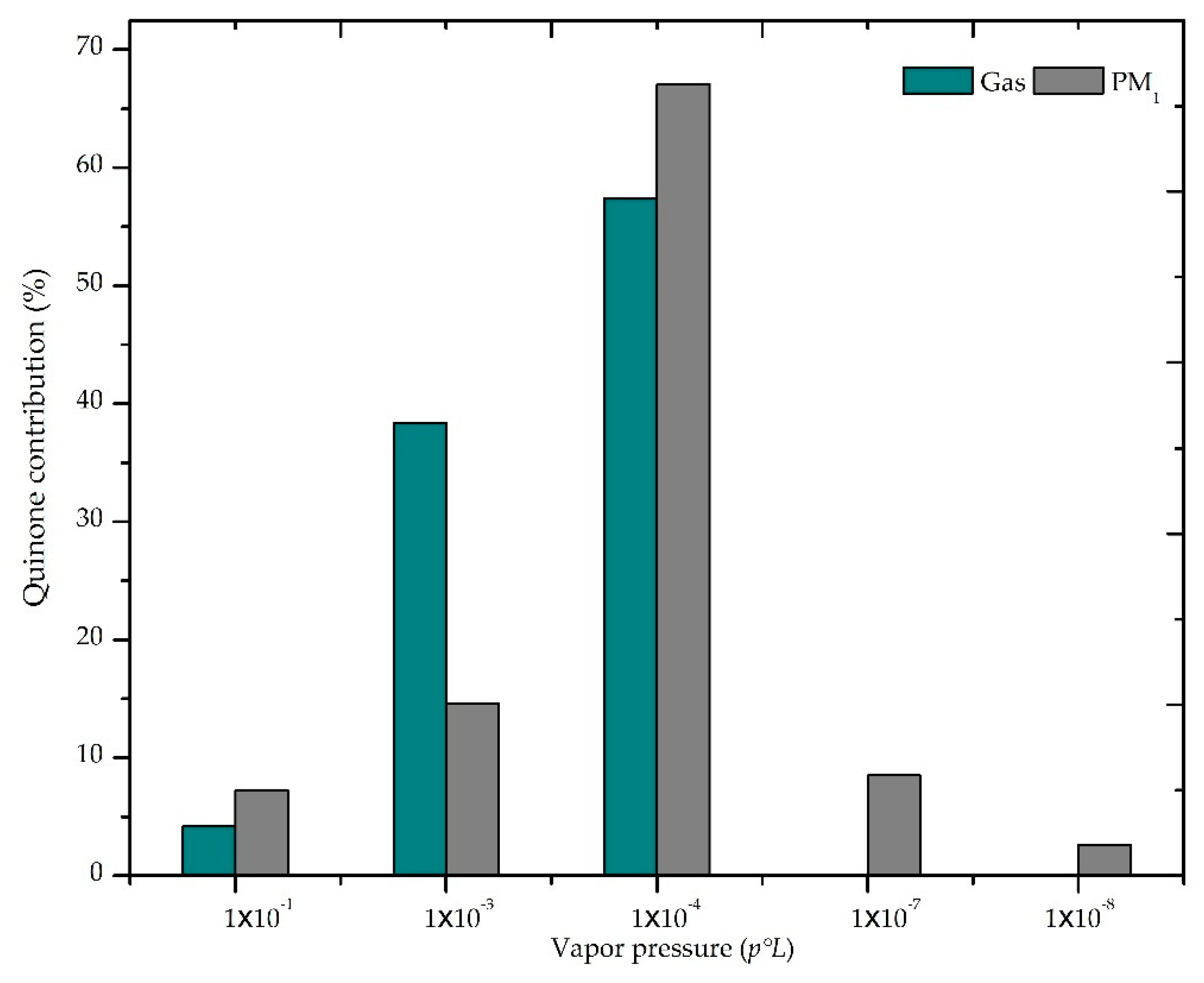
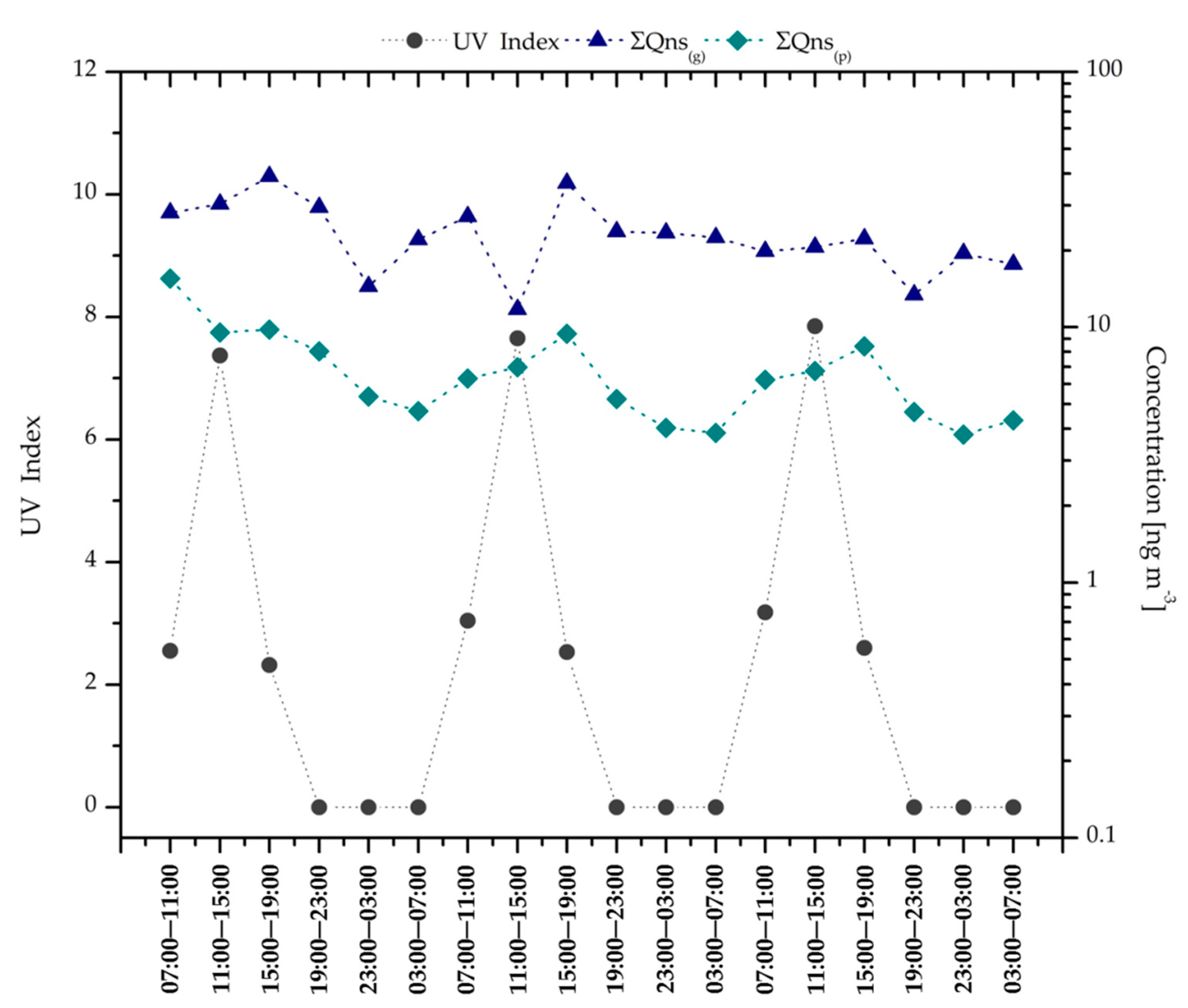
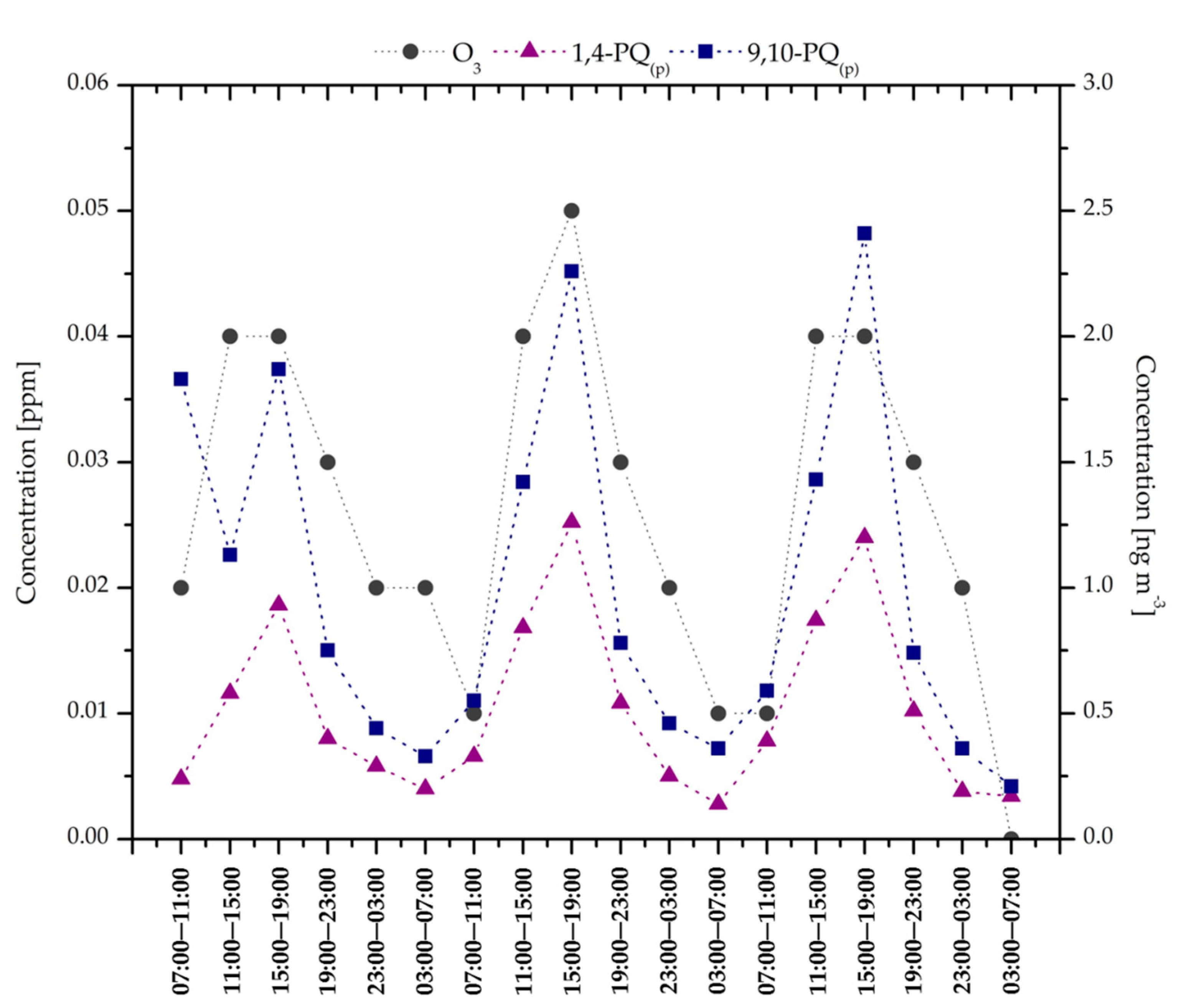
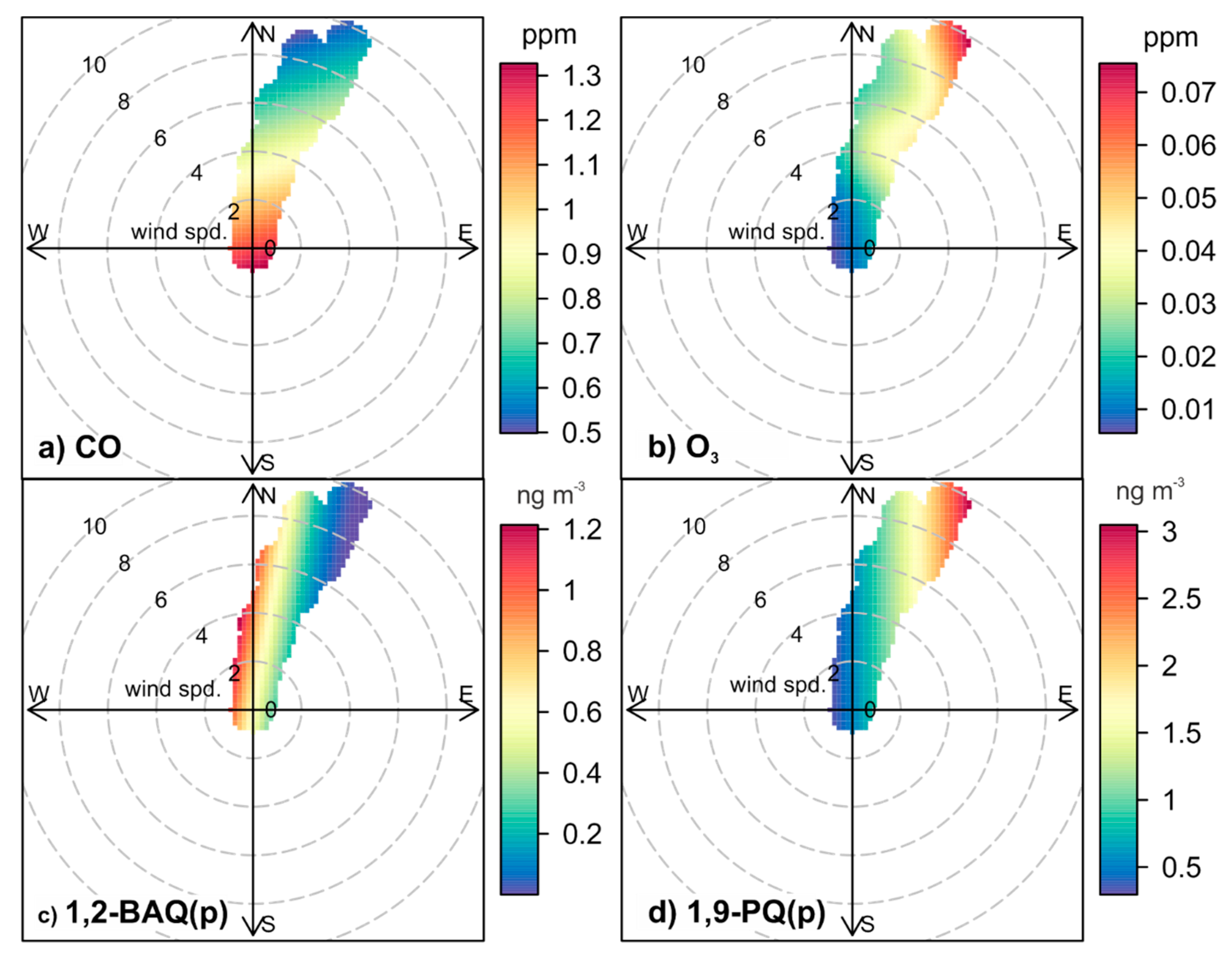
| PAHs * | Gas (ng m−3) | |||||
|---|---|---|---|---|---|---|
| 07:00–11:00 | 11:00–15:00 | 15:00–19:00 | 19:00–23:00 | 23:00–03:00 | 03:00–07:00 | |
| Nap | 352.2 (118.7) | 225.6 (58.73) | 206.6 (17.55) | 180.0 (41.20) | 235.4 (114.4) | 267.6 (56.70) |
| Acy | 41.1 (12.2) | 30.7 (3.7) | 39.4 (5.22) | 29.4 (5.76) | 34.7 (1.34) | 30.9 (4.41) |
| Ace | 4.86 (0.722) | 2.55 (1.33) | 1.44 (0.546) | 2.62 (1.67) | 1.93 (0.306) | 2.34 (0.891) |
| Fl | 13.7 (5.30) | 9.10 (2.16) | 9.89 (2.59) | 7.73 (2.08) | 9.41 (1.17) | 8.66 (1.45) |
| Phe | 18.8 (4.19) | 14.6 (5.45) | 17.2 (4.50) | 9.22 (5.87) | 13.6 (1.24) | 9.27 (0.985) |
| Ant | 1.99 (1.89) | 1.54 (0.174) | 1.64 (0.169) | 2.27 (1.31) | 1.38 (0.238) | 1.11 (0.114) |
| Pyr | 1.90 (0.0612) | 1.72 (0.0750) | 2.26 (0.558) | 1.79 (0.895) | 1.64 (0.277) | 1.10 (0.0432) |
| Chr | 0.018 (0.0036) | 0.089 (0.091) | 0.064 (0.045) | 0.055 (0.045) | 0.054 (0.046) | 0.0076 (0.0073) |
| PM1 (ng m−3) | ||||||
| Pyr | 0.52 (0.50) | 0.29 (0.20) | 0.16 (0.046) | 0.46 (0.51) | 0.15 (0.066) | 0.39 (0.13) |
| Chr | 0.64 (0.39) | 0.19 (0.17) | 0.032 (0.028) | 0.22 (0.23) | 0.12 (0.10) | 0.17 (0.028) |
| BbF | 2.19 (0.351) | 1.38 (0.181) | 0.986 (0.0687) | 1.76 (1.12) | 1.15 (0.0529) | 1.52 (0.418) |
| BkF | 1.75 (0.378) | 1.30 (0.328) | 1.02 (0.117) | 1.54 (0.796) | 1.13 (0.0831) | 1.30 (0.211) |
| BaP | 1.96 (0.744) | 1.59 (0.344) | 1.37 (0.202) | 2.37 (1.20) | 1.59 (0.293) | 1.95 (0.607) |
| Ind | 2.10 (0.219) | 1.29 (0.428) | 1.02 (0.150) | 1.81 (1.46) | 1.17 (0.113) | 1.46 (0.337) |
| Dib | 0.72 (0.42) | 0.19 (0.34) | 0.059 (0.046) | 0.28 (0.28) | 0.072 (0.054) | 0.10 (0.044) |
| BghiP | 1.97 (0.61) | 1.16 (0.34) | 0.76 (0.14) | 1.47 (0.98) | 0.97 (0.20) | 1.43 (0.44) |
| ΣPAHs (gas) | 434.4 (139.3) | 285.9 (58.63) | 278.7 (24.37) | 233.2 (50.02) | 298.1 (118.1) | 320.9 (55.99) |
| ΣPAHs (PM1) | 11.8 (1.68) | 7.40 (1.81) | 5.40 (0.599) | 9.92 (6.52) | 6.34 (0.458) | 8.31 (2.05) |
| ΣPAHs (Total) | 446.3 (140.3) | 293.4 (56.84) | 284.1 (24.97) | 243.1 (51.74) | 304.5 (118.3) | 329.3 (57.23) |
| Period | Phe/(Phe + Ant) | BaP/(BaP + Chr *) | BbF/BkF | Ind/(Ind + BghiP) | ||||
|---|---|---|---|---|---|---|---|---|
| Ratio | Reference | Ratio | Reference | Ratio | Reference | Ratio | Reference | |
| 07:00–11:00 | 0.91 | >0.70 Vehicular | 0.75 | >0.70 Gasoline | 1.25 | >0.50 Diesel | 0.52 | 0.35–0.70 Diesel |
| 11:00–15:00 | 0.91 | 0.85 | 1.06 | 0.53 | ||||
| 15:00–19:00 | 0.91 | 0.93 | 0.97 | 0.57 | ||||
| 19:00–23:00 | 0.8 | 0.9 | 1.14 | 0.55 | ||||
| 23:00–03:00 | 0.91 | 0.9 | 1.01 | 0.55 | ||||
| 03:00–07:00 | 0.89 | 0.92 | 1.17 | 0.51 | ||||
| Average ± SD | 0.88 ± 0.044 | 0.87 ± 0.067 | 1.09 ± 0.10 | 0.53 ± 0.022 | ||||
| ME a | (0.87–0.91) | (0.85–0.90) | (1.06–1.14) | (0.53–0.55) | ||||
| Quinones | Gas (ng m−3) | |||||
|---|---|---|---|---|---|---|
| 07:00–11:00 | 11:00–15:00 | 15:00–19:00 | 19:00–23:00 | 23:00–03:00 | 03:00–07:00 | |
| 1,4-NQ | 0.96 (0.48) | 1.9 (0.67) | 0.88 (0.57) | 0.79 (0.34) | 0.80 (0.32) | 0.58 (0.12) |
| 1,4-PQ | 2.0 (0.19) | 1.7 (0.081) | 2.3 (0.33) | 1.5 (0.36) | 1.9 (0.30) | 1.5 (0.14) |
| 9,10-PQ | 7.8 (3.1) | 7.7 (5.8) | 15.0 (7.5) | 9.6 (6.5) | 6.2 (2.4) | 7.5 (2.8) |
| 1,4-AQ | 8.4 (1.7) | 5.6 (2.6) | 9.4 (0.62) | 6.7 (1.7) | 6.7 (2.8) | 7.6 (0.78) |
| 9,10-AQ | 5.7 (1.5) | 4.1 (2.0) | 4.9 (1.5) | 3.6 (0.60) | 3.4 (0.85) | 3.5 (0.99) |
| PM1 (ng m−3) | ||||||
| 1,4-NQ | 0.53 (0.063) | 0.51 (0.042) | 0.48 (0.04) | 0.49 (0.039) | 0.47 (0.022) | 0.46 (0.077) |
| 1,4-PQ | 0.32 (0.075) | 0.77 (0.16) | 1.1 (0.18) | 0.48 (0.076) | 0.24 (0.047) | 0.17 (0.027) |
| 9,10-PQ | 0.99 (0.72) | 1.3 (0.17) | 2.2 (0.28) | 0.76 (0.023) | 0.42 (0.051) | 0.30 (0.080) |
| 1,4-AQ | 5.4 (3.2) | 4.4 (1.7) | 4.9 (0.94) | 3.8 (1.8) | 2.8 (0.5) | 2.7 (0.24) |
| 9,10-AQ | 0.045 (0.0070) | 0.088 (0.030) | 0.10 (0.019) | 0.057 (0.016) | 0.046 (0.0070) | 0.041 (0.010) |
| 1,2-BAQ | 1.9 (1.6) | 0.43 (0.34) | 0.16 (0.12) | 0.27 (0.12) | 0.26 (0.21) | 0.46 (0.25) |
| 1,4-CQ | 0.19 (0.019) | 0.21 (0.028) | 0.18 (0.054) | 0.13 (0.042) | 0.17 (0.079) | 0.17 (0.077) |
| ΣQns(gas) | 24.9 (6.96) | 20.9 (11.2) | 32.6 (10.5) | 22.2 (9.50) | 19.1 (6.67) | 20.7 (4.78) |
| ΣQns(PM1) | 9.35 (5.62) | 7.75 (2.43) | 9.21 (1.63) | 5.98 (2.14) | 4.40 (0.940) | 4.28 (0.692) |
| ΣQns(Total) | 34.3 (8.78) | 28.6 (10.6) | 41.8 (9.81) | 28.1 (9.76) | 23.5 (3.82) | 24.9 (2.65) |
© 2019 by the authors. Licensee MDPI, Basel, Switzerland. This article is an open access article distributed under the terms and conditions of the Creative Commons Attribution (CC BY) license (http://creativecommons.org/licenses/by/4.0/).
Share and Cite
Ojeda-Castillo, V.; Hernández-Paniagua, I.Y.; Hernández-Mena, L.; López-López, A.; Díaz-Torres, J.d.J.; Alonso-Romero, S.; del Real-Olvera, J. Observed Daily Profiles of Polyaromatic Hydrocarbons and Quinones in the Gas and PM1 Phases: Sources and Secondary Production in a Metropolitan Area of Mexico. Sustainability 2019, 11, 6345. https://doi.org/10.3390/su11226345
Ojeda-Castillo V, Hernández-Paniagua IY, Hernández-Mena L, López-López A, Díaz-Torres JdJ, Alonso-Romero S, del Real-Olvera J. Observed Daily Profiles of Polyaromatic Hydrocarbons and Quinones in the Gas and PM1 Phases: Sources and Secondary Production in a Metropolitan Area of Mexico. Sustainability. 2019; 11(22):6345. https://doi.org/10.3390/su11226345
Chicago/Turabian StyleOjeda-Castillo, Valeria, Iván Y. Hernández-Paniagua, Leonel Hernández-Mena, Alberto López-López, José de Jesús Díaz-Torres, Sergio Alonso-Romero, and Jorge del Real-Olvera. 2019. "Observed Daily Profiles of Polyaromatic Hydrocarbons and Quinones in the Gas and PM1 Phases: Sources and Secondary Production in a Metropolitan Area of Mexico" Sustainability 11, no. 22: 6345. https://doi.org/10.3390/su11226345
APA StyleOjeda-Castillo, V., Hernández-Paniagua, I. Y., Hernández-Mena, L., López-López, A., Díaz-Torres, J. d. J., Alonso-Romero, S., & del Real-Olvera, J. (2019). Observed Daily Profiles of Polyaromatic Hydrocarbons and Quinones in the Gas and PM1 Phases: Sources and Secondary Production in a Metropolitan Area of Mexico. Sustainability, 11(22), 6345. https://doi.org/10.3390/su11226345








